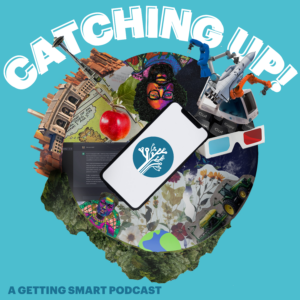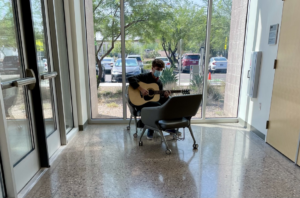Credentialing Everything: A Primer on Learning and Employment Records and Digital Wallets
Key Points
-
Credentials and learner records are accelerating the shift to competency-based learning.
-
They help learners manage unbundled learning by collecting evidence from multiple providers and provide quicker and more personalized onramps to high-wage employment.

According to Credential Engine, there are nearly one million credentials, yet many of these credentials are traditional institution-based aggregates of learning (certificates, degrees, etc.). However, as systems recognize the need to better verify and describe learner skills, credentials are beginning to also move beyond just degrees and certificates to a more granular talent signaling system. Credentials and learner records are accelerating the shift to competency-based learning. They help learners manage unbundled learning by collecting evidence from multiple providers and provide quicker and more personalized onramps to high-wage employment.
North Dakota implemented the first state-sponsored digital credential wallet for high school students during the 2022-23 school year. In Texas, students in the Dallas College system have access to their transcript via Greenlight Credentials, which they can selectively choose to share with employers. In New Hampshire, Concord’s Community College NHTI, is rolling out verified credentials in partnership with ProofSpace to store learner outcomes and extra-curricular experiences.
Kirstan Osborne, an educator from the Balmoral Hall School for Girls in Winnipeg, Manitoba, Canada shared how her school is working with Convergence Tech to distribute and store digital credentials and maintain wallets. When it comes to ownership, Osborne says that “Students will always have access to their credentials, regardless of whether the school continues to pay for the platform or not.” This characteristic of self-sovereignty is essential for digital wallets.
Osborne believes that this will allow the school to “improve student agency in learning, provide real-world context and the opportunity to look at learning through a different lens, and promote the idea that schools should be part of and not apart from the community.” As for students, they were pleased when they realized their potential for supporting resumés and post-secondary applications.
As employers continue to emphasize the need for both core (literacy, math, etc.) and transferable (collaboration, leadership, communication, etc.) skills, technology is accelerating to meet the need to match learner skills with employer needs. Below is a primer on what every school leader and innovative practitioner should know about the technology within the credentialing ecosystem.
Why
If all learning, whether from formal learning experiences in K-20 schools, industry-related credentials and experience (such as internships, work-based learning and apprenticeships), and out-of-system learning (currently not credited except via states that have passed Learn Everywhere legislation) could be curated in one place, learners will be better matched via demonstrated skills to employers looking for talent. Education is ready for a learner-centered digital learning and employment record stored in a digital wallet (or a set of interoperable wallets) owned by the learner. This would address persistent challenges that include:
- Difficulty in recording all of a learner’s educational experiences in one place.
- Inaccuracy in matching potential employees to employers due to the relatively limited methods to verify learning
- Given #2, using degrees as a proxy for new workplace talent which excludes significant numbers of potential candidates for employment.
- Inability to share skills and competencies from non-degree programs, incomplete degrees (never earned the final credential), or credentials for organizations that have closed.
- Cost of requesting and sharing proof of competency (ex. Asking for a college or high school transcript to be sent costs money).
Digital wallets enable individuals to store all Learning and Employment Records – a verifiable record of lifetime learning in one shareable space owned by the individual.
“Verifiable credentials are the most ideally suited standard for educational credentials. They extend digital trust to individuals, allowing them to hold their records and exchange them in secure, reliable, privacy-preserving ways. Together with decentralized identity, individuals can be in control of digital assets, online identity, and reputation.” — Kim Hamilton Duffy, Director of Identity and Standards, Centre Consortium.
How
Due to the technical nature of digital wallets, language can be confusing. To provide clarity, we provide the core definitions below.
- Learning and Employment Record (LER): Records of an individual’s verified skills, competencies, credentials, and employment accomplishments. An LER can be used to highlight verified skills and match people to employment opportunities. LERs are stored in digital wallets. While platforms like LinkedIn can publicly display this type of information, the LER adds verification to the record.
- Digital Wallet: A digital wallet in education is a technology solution that stores the verified learning completed by the individual. The wallet is owned by the individual and can be built on decentralized blockchain architecture (which generally means that the wallet platform is not owned by/stored on a single platform). This decentralized approach keeps data ownership with the user rather than a centralized entity (corporation or government).
- Self-sovereign: Gives individuals full ownership of their digital identities without needing to rely on a third party, thereby providing greater security of personally identifying information. Users can decide what to publicly and selectively share.
- Comprehensive Learner Record (CLR): The CLR is a technical specification built by 1EdTech to provide technical specifications for LERs. The CLR is the recommended standard for lifetime learning records by the American Association of Collegiate Registrars and Admissions Officers (AACRAO) and has been widely adopted by the credentialing ecosystem.
- Verified Credential: A credential that can be cryptographically verified and is not alterable. Examples can include birth certificates, employee identification cards and records and educational certificates. In education, these credentials often are a set of stacked LERs, which are also verified.
- Awarder (Issuer): The person or entity that creates and issues the credential to the holder.
- Trusted Issuer List: A machine-readable registry of credential awarders/issuers that meet a specific set of quality, accreditation or licensing criteria.
- Holder: The person or entity whose information is being stored in the verified credential.
- Reviewer: The entity which verifies that the virtual credential meets the requirement of the credential. In systems based on Web3 architecture, this can be done in a trustless environment, where interactions between two parties does not have to be mediated by a trusted third party.
- Machine-read: Information/data can be processed by a computer rather than relying on human interaction for processing and verifying the information.
- Interoperability: The ability of apps, computer programs, devices, or products to connect and communicate without the need for third parties. Through the ecosystem, individuals will have the ability to move data into and out of wallets, as well as between wallets.
A widely-adopted credentialing ecosystem will have seamless integration of awarders, holders, and reviewers working within an interoperable framework of LERs stored on the digital wallet. Organizations such as Velocity Network Foundation and Lightcast optimize the match between employers and prospective hires by scanning job databases and matching them with the public data from learner wallets or other collections of verified skills.
Institutions that award digital credentials will benefit from having to store all learner records to a decentralized user-controlled system that is easy, secure and affordable. Identity fraud will be reduced and the level of granularity to describe the skills of a learner will improve.
Digital wallets enable individuals to store all Learning and Employment Records – a verifiable record of lifetime learning in one shareable space owned by the individual.
Nate McClennen and Rachelle Dené Poth
What
The technology is readily available to serve this purpose. The challenge is to build a system that has choice and widespread adoption in the K12, higher ed, credentialing and employment sector. Displacing legacy practices such as digital transcripts that cannot be machine read, paying for paper copies of transcripts to be shared, and employer human resource departments that find it easier to use degrees as proxy for talent will be difficult.
Credential data can be stored within one or more digital wallets as a way to document the LER.
- GreenLight Credentials – provider of blockchain records for students, K-12 and Higher Ed institutions and employers. For K-12, it offers a “digital locker” that includes student information that enables students to control and share their academic records instantly.
- Territorium – offers verifiable records which includes competencies and skillsets, for students from K-12 and into the workforce. Territorium just launched its Life Journey platform that connects assessment, learner wallets, LER and skills-based job matching in a single platform.
- MIT Digital Wallet – open source wallet designed by the Digital Credentials Consortium
- LearnCard – open source digital and physical wallet. It is also a free app that can issue, earn, store and share credentials
- Disco.xyz – in beta, will be a way for individuals to have a personal data backpack and control and own what is shared
- Proof Space – interoperable identity hub wrapped with no-code tools for issuing and verifying reusable identity credentials – to both issue and store credentials.
Mastery Transcript Consortium, the leader in competency-based high school transcripts, has launched the MTC Learning Record (MLR). This MLR documents learning and allows the student to share the record with anyone through a portal where students can curate and display learning data. The MLR is interoperable and can be exported in CLR format to be stored in a digital wallet. MTC is working with partner districts in North Dakota to provide high school students with an LER that documents learning and is stored on the state-designed credential wallet. Approaches like this will become more widely adopted in LMS platform management in the future.
What can you do?
With all of the movement in this space over the last few years, it is difficult to imagine first steps. We recommend the following.
- Get educated. Get a wallet, earn a simple credential and store it in the wallet. Follow Ed3DAO, a decentralized education organization that helps the education sector understand wallets, credentialing, web3 and all other front-end technologies.
- Especially in secondary and higher education, now is the time to ensure that every course or program has a clear set of competencies that are linked to career-relevant skills. And, that these competencies are accurately assessed.
- Feeling innovative? Partner with a platform that will store verified credentials for your students in digital wallets owned by the user (and figure out who will pay the fees for as long as the wallet exists). Few districts and schools are doing this and you can lead the way.
- For educators, think about badging and credentialing your classroom. Most LMS platforms allow for this (D2L, Canvas, Schoology) and if not, other options exist such as Credly and Open Badges. Young people today will be employed in a marketplace of the future where badging and credentialing of individual competency is common-place. Give them practice.
- For higher-ed admissions officials, build the processes now to accept LERs from learner wallets as part of the admissions process.
- For employers, move beyond trusting resumes and believing that degrees are a proxy for talent. Build a human resources department that hires based on verified skills. The long term benefit is immense.

Nate McClennen







0 Comments
Leave a Comment
Your email address will not be published. All fields are required.